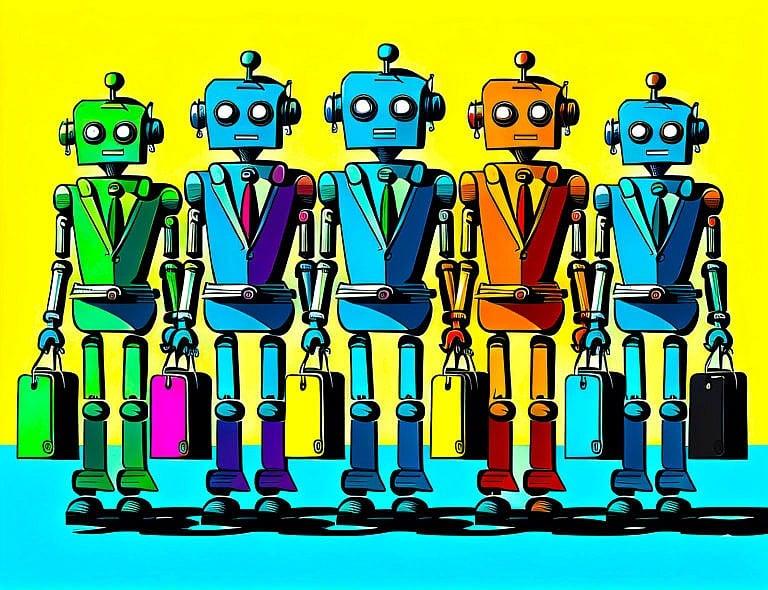AI will transform the labour market
Many white-collar workers will find themselves out of jobs

Share
Joel Blit is an associate professor of economics at the University of Waterloo.

Every few decades, a new technology comes along that fundamentally redefines society. The last significant one was the internet, and before that was computers. Artificial intelligence is the technology of our age.
How the transformation will unfold is not entirely a mystery. Disruptive technologies, from electricity to computers to the internet, have all followed a similar three-stage path of adoption. In the initial “replace” phase, the new technology displaces the old—and the old technology is often people. Electric light bulbs replaced gas lighting and, in factories, the electric engine replaced the steam engine.
However, it was not until the second phase—the “reimagine” phase, where people reinvent processes and business models around the new technology—that electricity created radical change. Factory layouts, no longer constrained by the need to connect each work station to a single power source, began to organize around the logical flow of materials, resulting in the modern assembly line. In the last phase, “recombine,” the new technology merges with other technology to create entirely new possibilities. Electricity eventually combined with advanced materials to create transistors and, ultimately, the computer.
AI will be no different. We find ourselves at the beginning of its replace phase, with managers in a broad range of industries breaking down processes to determine which constituent tasks can be better done with the most recent tech. Such tasks include writing, coding, ideation, research and data analysis, which large language models like ChatGPT can now perform.
The implication for people is straightforward. If most of your job is composed of tasks that ChatGPT can perform—as it is for roughly 20 per cent of Canadian workers—the outlook is bleak. ChatGPT may replace you entirely. But more likely, ChatGPT will become a tool that is integral to your job. It will allow workers to do more in less time such that fewer people will be needed. To take a historical example: spreadsheets did not entirely replace bookkeepers. But spreadsheet-equipped bookkeepers could maintain more financial records in less time, allowing accounting departments to reduce head counts.
AI is likely to take over much of the work of journalists, advertisers, paralegals and tax preparers, even doctors. If privacy hurdles can be overcome, a medically trained large language model will be able to interact with patients and make diagnoses. In most cases, it would decide on a course of action directly, leaving only the most complex cases to human physicians. To some extent, AI is already able to do this. In one recent study, both ChatGPT and a human doctor answered patient queries. When expert doctors compared the two, they consistently rated the responses by ChatGPT as not just more complete, but also more empathetic. Change is afoot in education too. While teachers may continue overseeing the class, a personal AI tutor might identify specific students’ needs, determine their best way of learning, generate customized content and answer their questions.
It is almost impossible to predict which jobs will be displaced in the reimagine phase. In this phase, entire industries will be disrupted and with them their workers, regardless of skills or occupation. For example, when Amazon used the internet to reinvent retail, brick and mortar bookstores were closed and staff lost their jobs. Of course, the new business models of internet-age pioneers like Amazon, Meta and Google also created new jobs to replace the old. But the transition was difficult for workers and many saw a permanent drop in their wages.
More than the loss of jobs, the lasting legacy of most disruptive technologies is a redistribution of income. When industrial robots automated car plants and other factories, they displaced workers at the lower end of the skill and wage distribution. Computers emptied out the middle of the skill distribution while making white-collar workers more productive and increasing their relative wages. With AI, we have the first disruptive technology that looks set to primarily displace white-collar workers. We may have a technology that actually decreases income inequality.
Too often, with disruptive technologies, we focus on the risks and overlook its prospective benefits. The broader context is that Canada has a large productivity and innovation gap. Over the last 50 years, our economy has experienced the slowest growth of any G7 country, and the prediction for the next decades is just as dire. This poses an existential threat to our public health care and education, perhaps the two things that as Canadians we identify with most. Fortunately, AI is set to shake the foundations of the economy, presenting Canada an opportunity to change our trajectory. To do that, we must embrace AI.
We reached out to Canada’s top AI thinkers in fields like ethics, health and computer science and asked them to predict where AI will take us in the coming years, for better or worse. The results may sound like science fiction—but they’re coming at you sooner than you think. To stay ahead of it all, read the other essays that make up our AI cover story, which was published in the November 2023 issue of Maclean’s. Subscribe now.